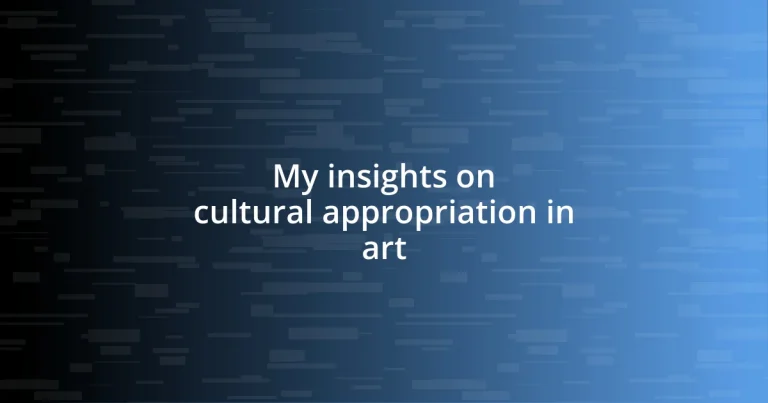Key takeaways:
- Cultural appropriation involves borrowing elements from another culture without understanding or respecting their context, often leading to commodification and exploitation.
- True appreciation of art from different cultures requires engagement, collaboration, and honoring the original creators, transforming admiration into respect.
- Inclusive artistic practices necessitate ongoing education, genuine connections, and fostering dialogues that elevate cultural stories beyond aesthetic value.
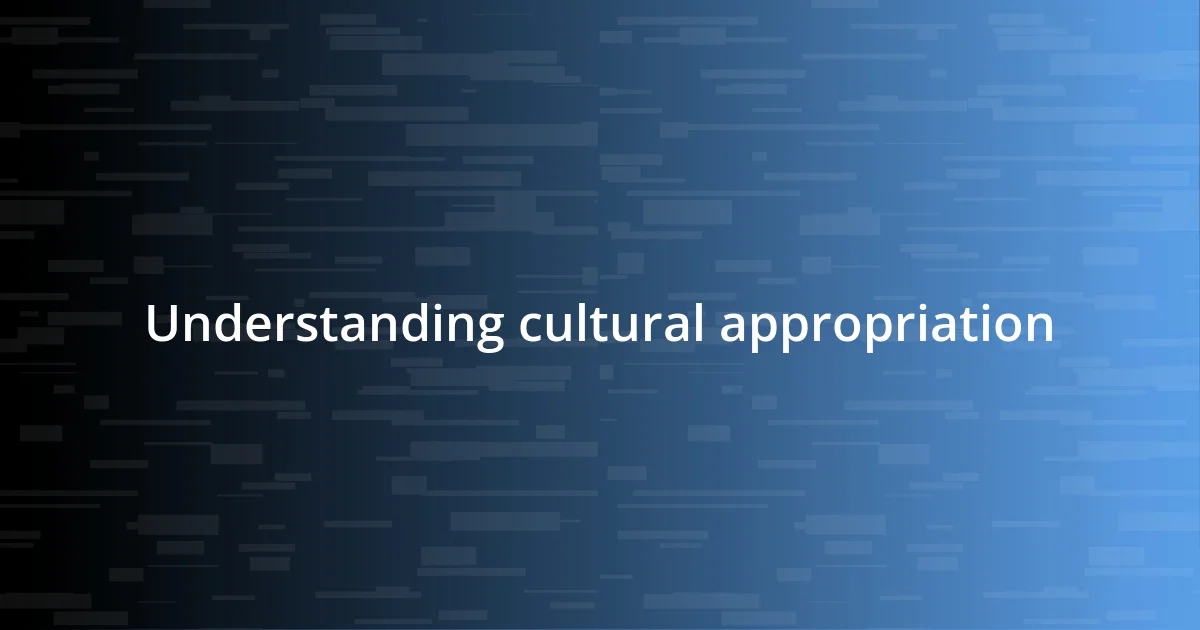
Understanding cultural appropriation
Cultural appropriation is often described as the act of taking or borrowing elements from one culture by members of another, typically in a way that disregards the original context or significance. I remember a time when I stumbled upon a beautifully crafted dress that blended traditional designs from my heritage with modern aesthetics. It felt like a clash of appreciation versus ownership—was I celebrating my culture, or just commodifying it?
As I reflect on this, I can’t help but wonder: what responsibilities do we hold when we appreciate art from different cultures? There’s an emotional weight that accompanies the act of borrowing. It’s not just about the outward appearance but also about understanding the history and struggles behind those artistic expressions. This has led me to consider the impact of power dynamics. Who gets to decide what is shared and what is sacred?
Navigating cultural lines can be tricky, and I have had my moments of confusion. One time, while attending an art exhibition, a piece inspired by Indigenous art sparked a heated discussion among my friends. They raised valid points about respect versus appropriation. It made me realize that those conversations—while sometimes uncomfortable—are crucial to understanding the impact art can have on culture and identity. How do we ensure that our engagement with each other’s cultures is enriching rather than exploitative?
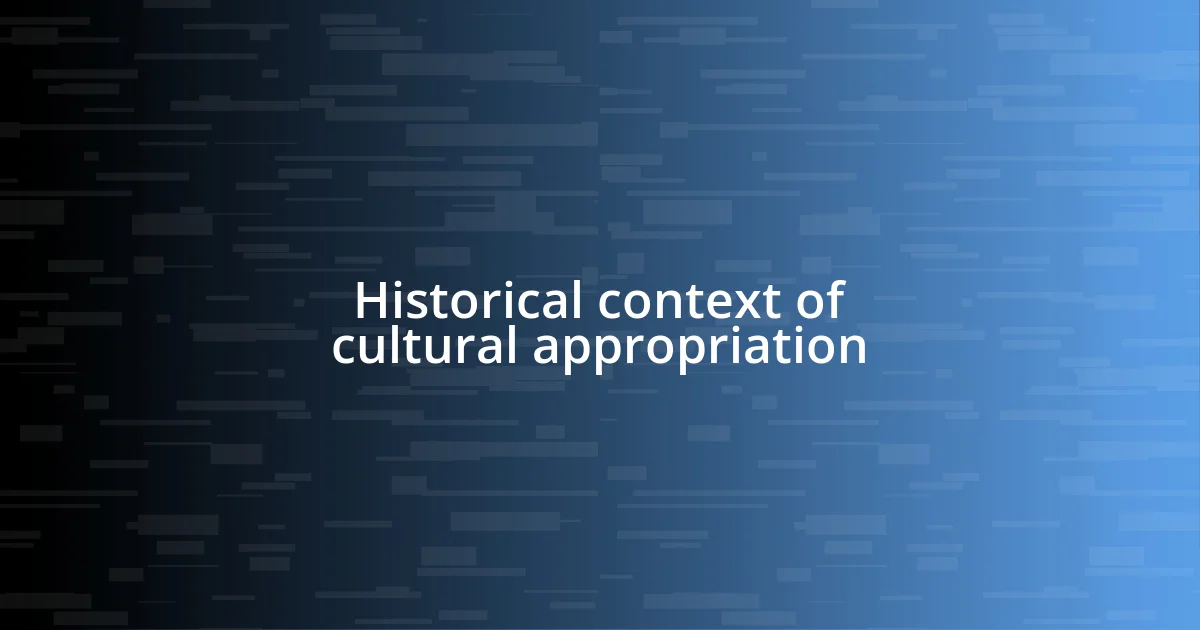
Historical context of cultural appropriation
Throughout history, cultural appropriation has often intertwined with colonialism and power dynamics. I recall reading about how European artists in the 19th century would adopt styles from Indigenous peoples without acknowledging their origins. It was fascinating yet troubling; these artists would portray exoticism but seldom understand the underlying cultural significance or the historical traumas involved.
- From the late 19th to early 20th centuries, art movements like Impressionism began to draw from Japanese woodblock prints, showcasing how appropriation can sometimes mask admiration.
- The Harlem Renaissance highlighted African American culture, yet some mainstream artists appropriated elements without honoring their origins.
- In the 1990s, debates arose over Native American motifs used in fashion, revealing an ongoing struggle between cultural appreciation and disrespect.
These examples illustrate an uncomfortable truth: appropriation often occurs when privilege meets ignorance. I’ve come to realize that it’s vital to dig deeper, beyond the surface. It requires us to consider not just what we borrow, but the stories and struggles left in the shadows of our creative expressions.
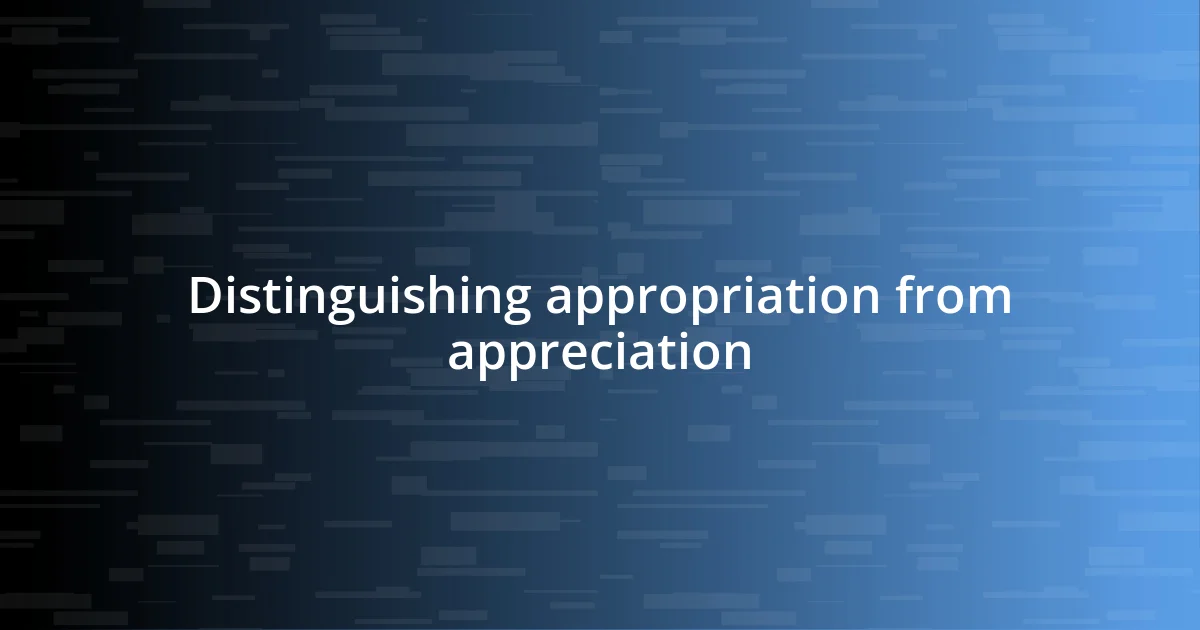
Distinguishing appropriation from appreciation
Understanding the line between appropriation and appreciation often requires a nuanced perspective. For example, I once attended a workshop on traditional Native American pottery. The instructor emphasized the importance of knowing the stories behind each design and the spiritual significance they hold. Engaging with this knowledge transformed my initial appreciation into a more respectful admiration. It made me question: am I merely enjoying the art for its aesthetic value, or am I acknowledging the rich heritage and stories it represents?
I’ve also noticed that appreciation often comes from engagement and collaboration. Visiting a local art gallery last summer, I encountered a series of paintings by an artist who respectfully integrated elements from various cultures. The artist had collaborated with artisans from those cultures, ensuring that the original creators were involved and acknowledged. That experience highlighted the importance of context and dialogue. When we involve and elevate the voices of the cultures we admire, we create a space for true appreciation rather than appropriative behavior.
To further clarify these concepts, I find it useful to compare the principles behind appropriation and appreciation side by side. This juxtaposition helps me articulate my thoughts more clearly, and I believe it can benefit others navigating this complex topic.
| Appropriation | Appreciation |
|---|---|
| Disregards cultural significance | Honors and respects original culture |
| Often driven by power dynamics | Encourages collaboration and dialogue |
| Commodifies cultural elements | Seeks to understand and learn |
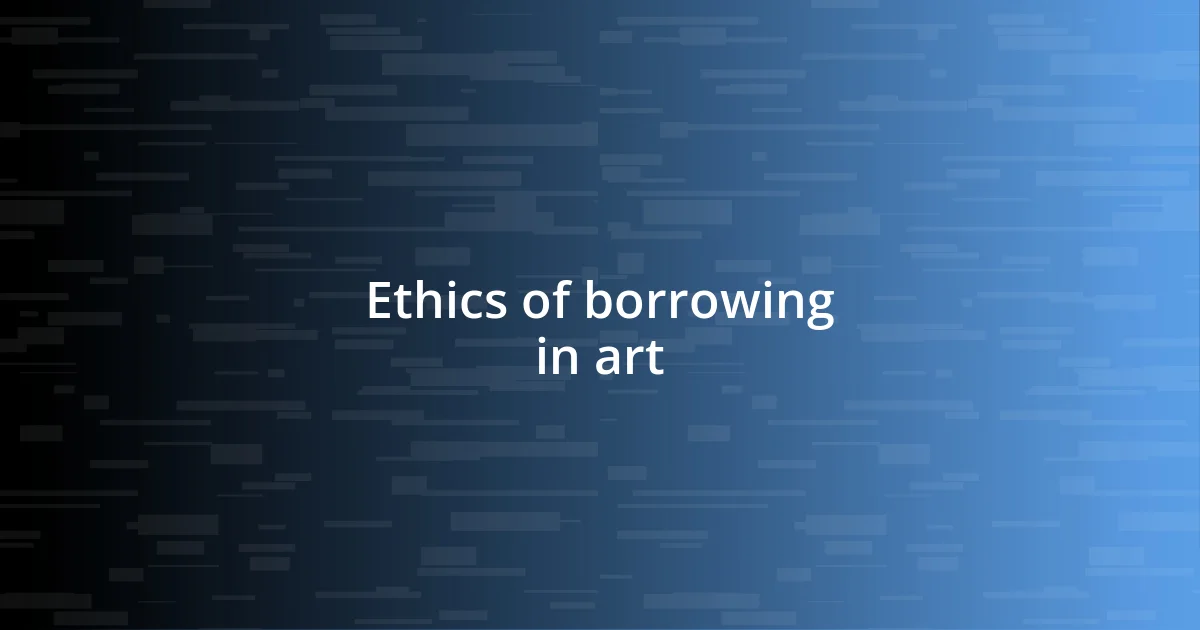
Ethics of borrowing in art
Ethics in borrowing art is a delicate dance between inspiration and exploitation. I remember an exhibition where an artist showcased work inspired by Indigenous patterns. As I walked through, I felt a tinge of discomfort; these patterns carried profound meaning within their culture. Were they truly borrowed with respect, or was this merely a trend? This moment made me reflect on how important it is for artists to understand the weight of what they take from others.
In my experience, the ethical dilemma often lies in the artist’s intent. I once met a painter who incorporated African motifs into her work. Instead of claiming ownership, she openly acknowledged her sources and their histories, fostering an honest conversation about cultural intersections. This approach invited a sense of authenticity and humility I found refreshing. It made me wonder: How often do we see this kind of respectful engagement in the art world?
Furthermore, I often ask myself whether our society has created a space for true artistic dialogue. After attending a panel discussion on cultural borrowing, it struck me how vital it is for artists to seek out collaborations rather than just appropriation. By forming relationships with the cultures they draw from, artists can create work that honors the lineage of inspiration they pull from, enriching their art and the communities involved. Isn’t this what art is all about—connection and understanding?
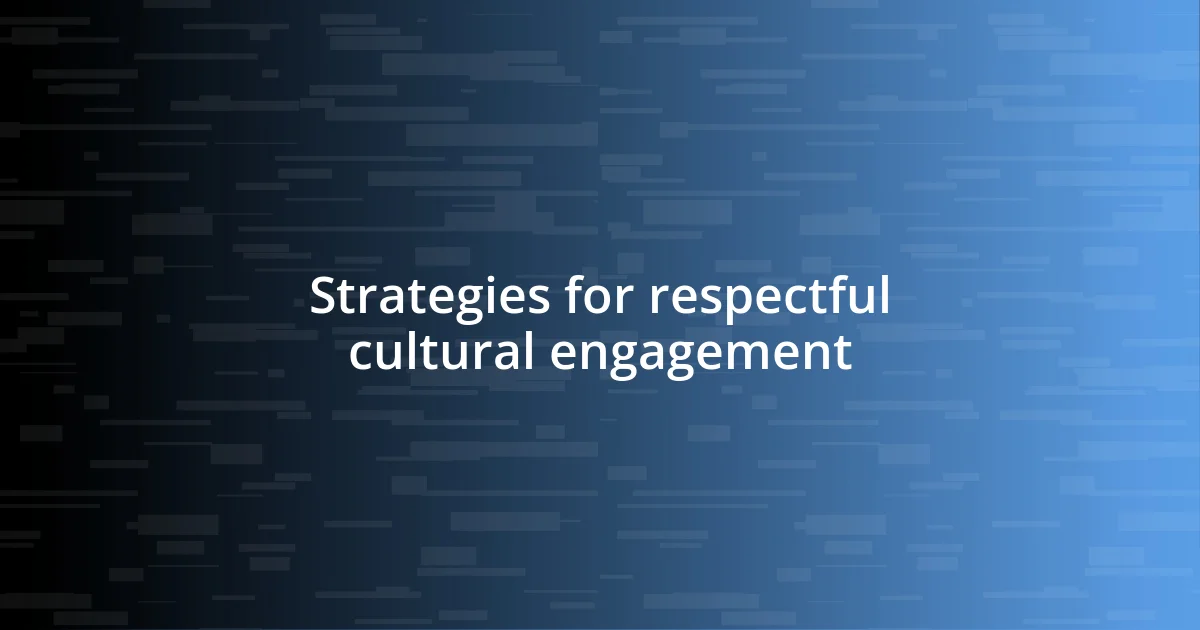
Strategies for respectful cultural engagement
In my journey of exploring cultural engagement, I’ve found that listening deeply to the voices of the cultures we admire is essential. I remember visiting a festival that celebrated different cultural heritages. The organizers invited speakers from various communities to share their stories and histories. Being present for those discussions opened my eyes. It made me realize how deeply we can connect when we approach cultural elements with genuine curiosity and openness.
A powerful strategy I often reflect on is collaboration. I once attended a workshop where a group of artists collaborated across cultural boundaries to create a mural. The process wasn’t just about blending styles; each artist shared their narrative and contributed their unique perspective. I marveled at how the mural transformed into a rich tapestry that honored each culture. It took me back to the thought: how often do we allow ourselves to engage in such authentic partnerships?
Lastly, I believe that educating oneself is pivotal. Whether through books, documentaries, or conversations, understanding the context and significance of cultural elements is invaluable. I recall reading a book on global art traditions. The insights gained not only enriched my appreciation but also prompted me to consider my role as a consumer of culture. It raised the question: what responsibility do we hold in ensuring that cultural representations are respectful? Through knowledge, we don’t just engage; we engage thoughtfully and responsibly.
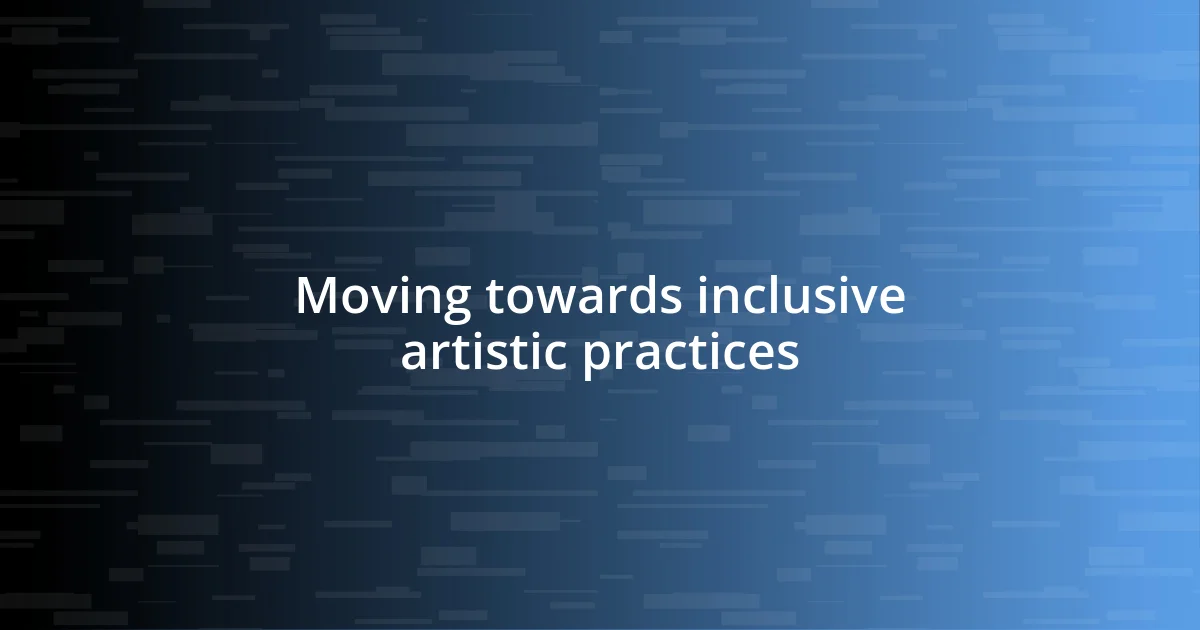
Moving towards inclusive artistic practices
Embracing inclusive artistic practices requires a genuine commitment to understanding and valuing the cultures we engage with. I remember a conversation I had with a sculptor who sought out mentorship from Indigenous artists. His journey was not just about skill but about forging connections. He shared how these relationships informed his work in profound ways, transforming his art into a platform for community stories rather than mere aesthetic choices. Isn’t it fascinating how collaboration can elevate art beyond the individual, allowing it to resonate more deeply?
I’ve often found that sharing space—whether in a gallery or a studio—can break down barriers in the artistic community. At a recent group exhibit, artists from diverse backgrounds displayed their works side by side. As I wandered through, I noticed how the different narratives interwove, creating a dialogue that sparked curiosity and appreciation. This experience reminded me of the power of visibility; it made me question how often we see such inclusive showcases in the mainstream art scene. Why not celebrate our differences together instead of apart?
Ultimately, I believe that artists who truly wish to foster inclusivity must adopt a continuous learning mindset. I recall attending a workshop on the significance of storytelling in art led by artists from various backgrounds. Their insights challenged my assumptions and opened my eyes to the layers of meaning behind certain symbols. This experience reinforced something vital: we must go beyond surface-level engagement and dive deeper into the cultural narratives that shape our world. Isn’t that what art is meant to do—encourage us to explore the complexities of human experience?












